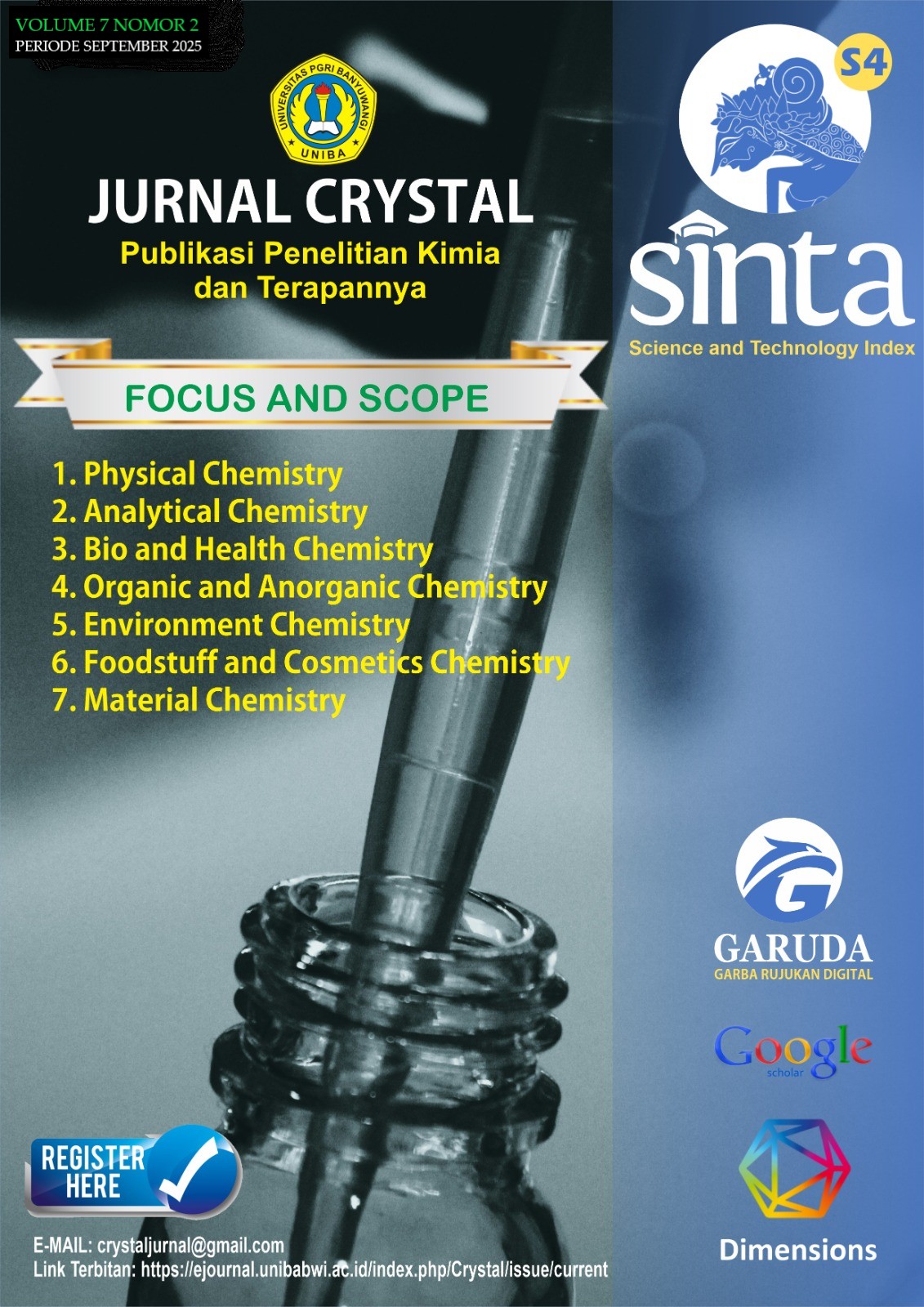SINTESIS DAN KARAKTERISASI POLIMER BERCETAKAN MOLEKUL TARTRAZIN UNTUK PEMISAHAN WARNA TARTRAZIN PADA KERUPUK
DOI:
https://doi.org/10.36526/jc.v7i2.6280Keywords:
Tartrazine, molecular-printed polymer, methacrylate acid, FTIR.Abstract
Tartrazine (E102) is a synthetic food dye that imparts a bright lemon-yellow coloration. The compound is composed of phenolic derivatives, polycyclic hydrocarbons, and heterocyclic structures. Its extensive application in the food sector is attributed to its remarkable stability against light, oxygen, heat, and pH variations, along with its relatively low production cost. In Indonesia, the National Agency of Drug and Food Control (BPOM) authorizes the use of tartrazine at a maximum concentration of 70 mg/kg in food and beverage products. However, excessive consumption may trigger adverse health effects such as allergic responses, skin irritation, migraines, and visual disturbances. Detection of tartrazine using molecularly imprinted polymers (MIPs) offers greater selectivity and precision compared to conventional analytical techniques. In this work, MIP was synthesized employing methacrylic acid (MAA) as the functional monomer, tartrazine as the template molecule, trimethylolpropane trimethacrylate (TRIM) as the crosslinking agent, benzoyl peroxide (BPO) as the radical initiator, and dimethylformamide as the porogenic solvent. The synthesized polymer was evaluated alongside a non-imprinted polymer (NIP) and characterized through FTIR, TGA, and SEM analyses. FTIR spectra revealed absorption bands at 1149.57 cm⁻¹, 1732.08 cm⁻¹, 2966.52 cm⁻¹, and 3441.01 cm⁻¹, corresponding respectively to C–H bending, carboxylate C=O stretching, C–H stretching, and O–H vibrations. The research results showed that a sample of crackers sold in a shop in the city of Bandung contained 0.42 mg/g or the equivalent of 420 mg/kg with a recovery of 95.47%.
References
Amchova, P. et al. (2024) Food Safety and Health Concerns of Synthetic Food Colors, International Journal of Food Science, 2024, Article 556123.
Cheng, S., Tang, D., Zhang, Y., Xu, L., Liu, K., Huang, K. & Yin, Z. (2022) Specific and sensitive detection of tartrazine on the electrochemical interface of a molecularly imprinted polydopamine-coated PtCo nanoalloy on graphene oxide, Biosensors, 12(5), 326. doi:10.3390/bios12050326.
European Food Safety Authority (EFSA) (2025) ‘Re-evaluation of Tartrazine (E 102) as a Food Additive’, EFSA Journal, 23(7), e09461.
Hernandez, C.J., Medina, R., Maza Mejía, I., Hurtado, M., Khan, S., Picasso, G., López, R. & Sotomayor, M.D.P.T. (2024) ‘Preparation of a molecularly imprinted polymer on polyethylene terephthalate platform using reversible addition–fragmentation chain transfer polymerization for tartrazine analysis via smartphone’, Polymers, 16(10), 1325. doi:10.3390/polym16101325.
Jacinto, C., Maza Mejía, I., Khan, S., Lopez, R., Sotomayor, M.D.P.T. & Picasso, G. (2023) Using a smartphone-based colorimetric device with molecularly imprinted polymer for the quantification of tartrazine in soda drinks, Biosensors, 13(6), 639. doi:10.3390/bios13060639.
Novais, C. et al. (2022) Natural Food Colorants and Preservatives: A Review, Frontiers in Nutrition, 9, 1–16. [PMCID: PMC9776543].
Roohollah, S. & Larki, A. (2017) Pre-Concentration and Determination of Tartrazine Dye from Aqueous Solutions Using Modified Cellulose Nanosponges, Ecotoxicology and Environmental Safety, 135, 123–129.
Rovina, K., Siddiquee, S. & Shaarani, M.S. (2017) A review of extraction and analytical methods for the determination of Tartrazine (E 102) in foodstuffs. ISSN 1547-651.
Rubio, F.T.V. et al. (2025) Artificial dyes: Health risks, environmental concerns, and current regulations, Food Control, 161, 110256.
Ruiz-Cordova, G.A., Vega-Chacón, J., Sotomayor, M.D.P.T., Tuesta, J.C., Khan, S. & Picasso, G. (2024) Development of an optical sensor using a molecularly imprinted polymer as a selective extracting agent for the direct quantification of tartrazine in real water samples, Polymers, 16(6), 733. doi:10.3390/polym16060733.
Sahraei, R., Farmany, A. & Mortazavi, S.S. (2013) A nanosilver-based spectrophotometry method for sensitive determination of tartrazine in food samples, Food Chemistry, 138, 1239–1242.
Sato, N., Mori, M. & Itabashi, H. (2013) Cloud point extraction of Cu(II) using a mixture of triton X-100 and dithizone with a salting-out effect and its application to visual determination, Talanta, 117, 376–381.
Seo, H., Lee, S.Y., Lee, J.H., Park, S.Y. & Kim, M. (2024) Quantitative analysis of seven commonly used synthetic food color additives by HPLC-PDA, Applied Biological Chemistry, 67(1), 45.
Singh, T. et al. (2023) Natural bio-colorant and pigments: Sources and current trends, Current Opinion in Food Science, 51, 100940.
Stich, E. (2016) Food color and coloring food: quality, differentiation and regulatory requirements in the European Union and the United States, Cambridge (UK), pp. 3–27.
Wang, X., Zhang, Y. & Zhao, H. (2024) Molecularly imprinted solid-phase extraction: Recent strategies, future prospects, and forthcoming challenges in complex sample pretreatment processes, TrAC Trends in Analytical Chemistry, 174, 117986.
Downloads
Published
How to Cite
Issue
Section
License
Copyright (c) 2025 Junita Br Sembiring

This work is licensed under a Creative Commons Attribution 4.0 International License.















